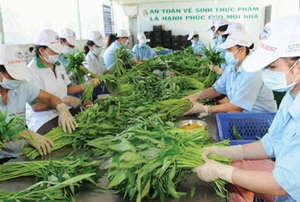 lobal economic crisis has greatly influenced export turnover of some of Vietnam’s key exports such as pangasius, frozen shrimp and rice. Nevertheless, since 2007 to date, export of vegetables has seen growth as the U.N. Food and Agriculture Organization (FAO) said that demand of vegetables in the world has increased by 3.6 percent per year while output has increased only 2.8 percent.
lobal economic crisis has greatly influenced export turnover of some of Vietnam’s key exports such as pangasius, frozen shrimp and rice. Nevertheless, since 2007 to date, export of vegetables has seen growth as the U.N. Food and Agriculture Organization (FAO) said that demand of vegetables in the world has increased by 3.6 percent per year while output has increased only 2.8 percent.Turnover of some export items such as rice, cashew and seafoods was US$1 billion five years ago, when this situation began improving in 2007.
According to the Fruit and Vegetable Association (Vinafruit), exporters touched $305 million in revenues in 2007 and this figure is spiraling every year. The figures are $407 million, $628 million, $829 million in 2008, 2011 and 2012, respectively.
Vinafruit said fruit and vegetable exports this year are expected to increase to $1 billion.
This can totally be achieved as turnover of fruits and vegetables export in first four months increased by 17 percent against the same period last year.
The Ministry of Agriculture and Rural Development said the Plant Protection Department is working with countries to clear quarantine barriers of blue dragons, rambutans and longan into the US, Japan, and Australian markets. From June 30, fresh fruits and vegetables will be export to EU countries.
The Ministry has said the figure of $1 billion is within reach if the country can grasp the opportunity to focus on key export items and meet GlobalGAP standards when the rising global demand for farm produce is benefiting Vietnam’s sector this year.
Professor Nguyen Quoc Vong, who used to work in the Ministry of Agriculture in New South Wales in Australia is currently working in Royal Melbourne Institute of Technology in Vietnam, said the country has been listed as one of the world’s five biggest farm produce exporters with revenues of around $10 billion a year.
Other farm produce like tea, cashew and pepper also yield $3 billion annually, while vegetables bring in $103 billion a year. Vietnamese fruits and vegetables export is much dependent on the Chinese market--an unstable and risky potential market.
The country has 1.4 hectares under fruit and vegetable cultivation, according to the Ministry of Agriculture and Rural Development. The area is seven million hectares less that paddy.
In addition, fruits and vegetables are planted in a smaller scale resulting in unstable quality and are consumed within the country only. In the future, farmers should cooperate with each other to create bigger farms for better production.





